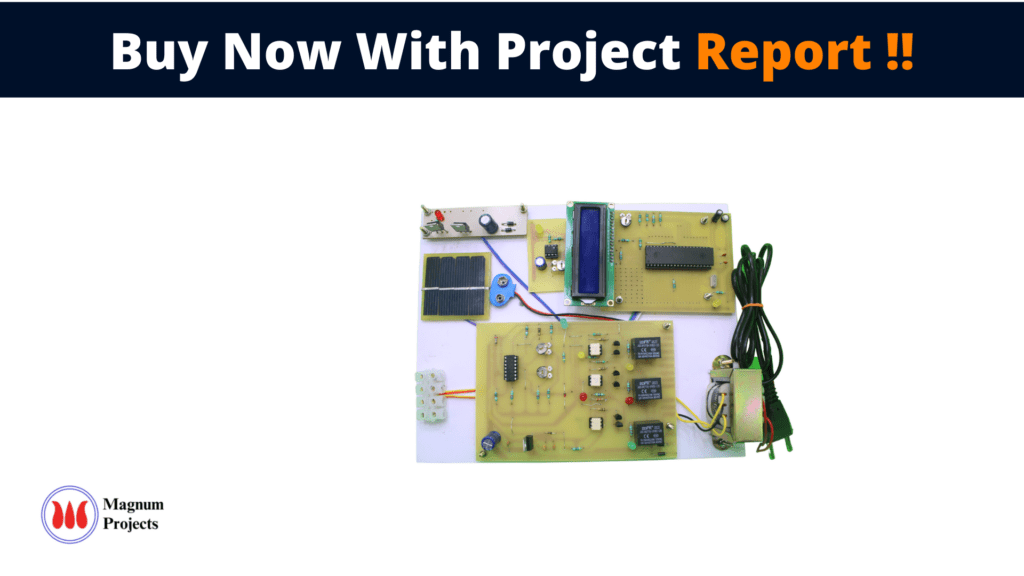Table of Contents
Introduction:

Since human evolution, mankind has exploited naturally available resources such as Wind, Water & Solar energy. The availability of resources restricts the use of Wind and Water energies as alternative power sources. But Sun is available since the birth of the solar system and will remain there as a single infinite energy source.
There are some hopes that the sun will become a main source of energy in the 21st century. By then, sources of oil will be almost exhausted and will only play a minor part in the supply of energy. The present interest in solar energy is therefore not surprising. Some work has already been done with solar cells and solar panels.
Most of the energy that we get from the greatest reservoir of energy, the Sun, remains unused. The only way to store the energy from the sun is to convert it into electrical form and then use this electrical signal to charge batteries and thus store the energy in chemical form. For this, we make use of solar panels consisting of solar cells. The solar cell gives an electrical output that is proportional to the intensity of light falling over it.
The other novel feature of this project or system is to check the day-light intensity and accordingly switch the appropriate loads. This decision is done by electronic means and one or two loads are switched on, which are needed for that condition.

Block diagram explanation:
Power supply unit
This section needs two voltages viz., +12 V & +5 V, as working voltages. Hence specially designed power supply is constructed to get regulated power supplies.
Microcontroller:
The Atmel AT89 series is an Intel 8051-compatible family of 8-bit microcontrollers (µCs) manufactured by the Atmel Corporation. Based on the Intel 8051 core, the AT89 series remains very popular as general-purpose microcontrollers, due to their industry standard instruction set, and low unit cost. This allows a great amount of legacy code to be reused without modification in new applications. While considerably less powerful than the newer AT90 series of AVR RISC microcontrollers, new product development has continued with the AT89 series for the aforementioned advantages.
Comparator:
In electronics, a comparator is a device that compares two voltages or currents and outputs a digital signal indicating which is larger. It has two analog input terminals and
one binary digital output
. The output is ideally

A comparator consists of a specialized high-gain differential amplifier. They are commonly used in devices that measure and digitize analog signals, such as analog-to-digital converters (ADCs), as well as relaxation oscillators
Buffers
Buffers do not affect the logical state of a digital signal (i.e. a logic 1 input results in a logic 1 output whereas logic 0 input results in a logic 0 output). Buffers are normally used to provide extra current drive at the output but can also be used to regularize the logic present at an interface
Drivers
This section is used to drive the relay where the output is the complement of input which is applied to the drive but the current will be amplified
Relays
It is an electromagnetic device that is used to drive the load connected across the relay and the o/p of the relay can be connected to the controller or load for further processing.
Methodology:
This project implements a new feature which is not yet been implemented in the real-time market. As now we know how the solar inverter or solar charger works, when solar energy falls onto solar panels then it induces electricity, and that energy is stored in the battery, later that energy is being utilized for running home appliances.
Now the condition is, the battery which is used to store the charges gets charged earlier time the rest of the time when the sun is available and the solar panel which is generating the charges is not utilized as the battery is fully charged. So this project is designed to utilize this energy without wasting it.
When the battery is fully charged then the next stage is to shift the charging point or the power line towards the grid or Electricity board so that wastage can be minimized and the power can be delivered to EB.
By delivering the power to EB we can save maximum power and we can have a mini power generation plant in the local station. And even every individual can earn by lending power to EB, this will be motivation for each individual to adopt this technology and serve the country for a new future. This project monitors how many units we are transferred to the EB and what is the total amount the EB has to pay.
Advantages:
- High reliability, due to the usage of power semiconductor devices.
- The system is monitored without any difficulty (no need for full attention).
- As this system uses both Solar Energy and Mains Supply to charge its Battery, the chances of facing Black-out conditions are very less.
- No wastage of power and effective implementation.
- The system costs less with reliability and longer life.
- Lower weight because of reduction in components. And expenditure on care & maintenance of the system is negligible.
- It can be used as a decentralized energy system right at the place of use; hence there is no need for a transmission line.
Disadvantages:
- Low conversion efficiency.
- High capital cost to install.
Applications:
- Consumer engagement.
- Renewable energy
- Smart home
- Smart grid
- Plug-in electric vehicles




